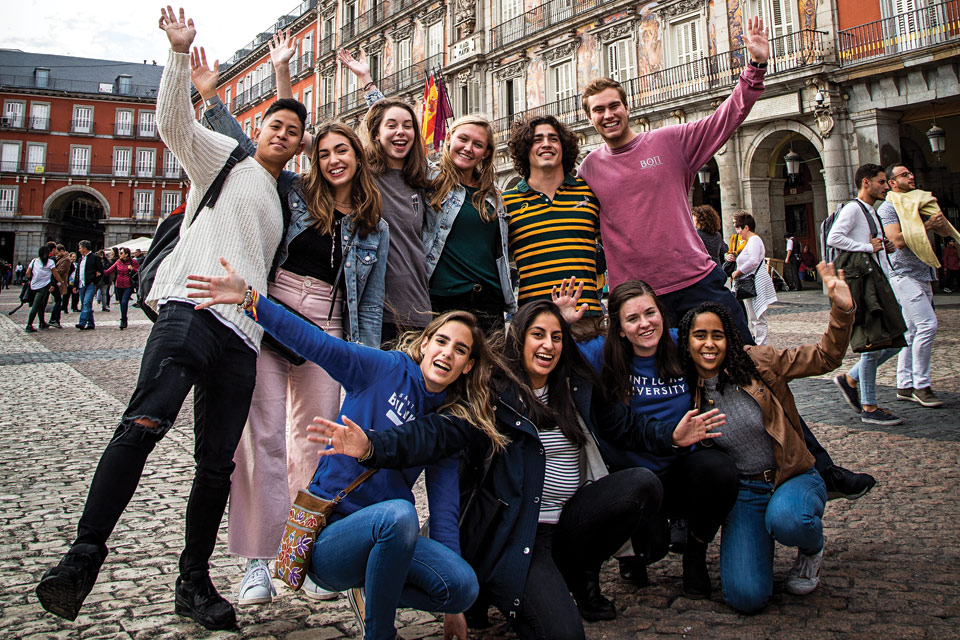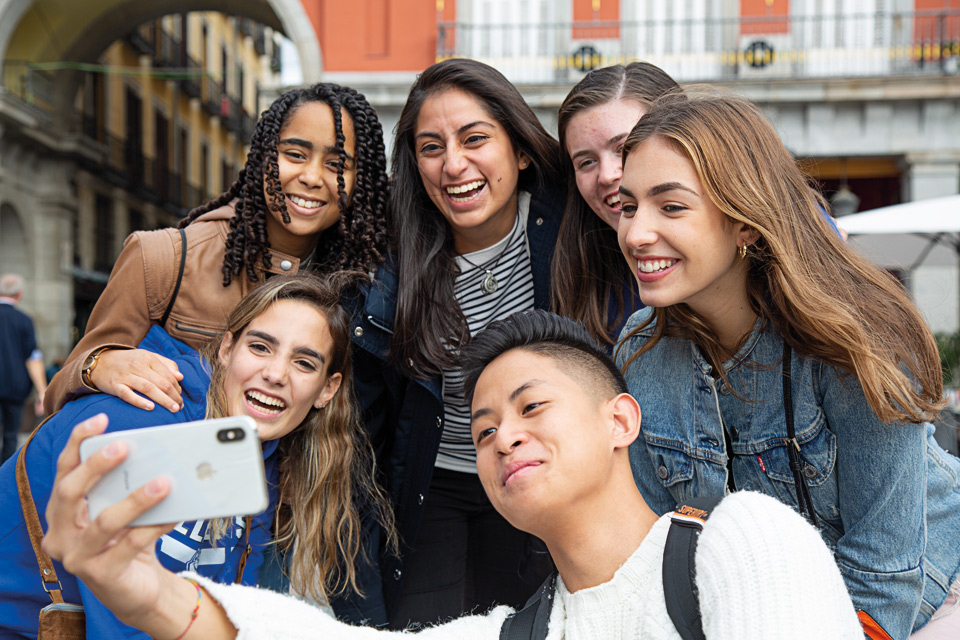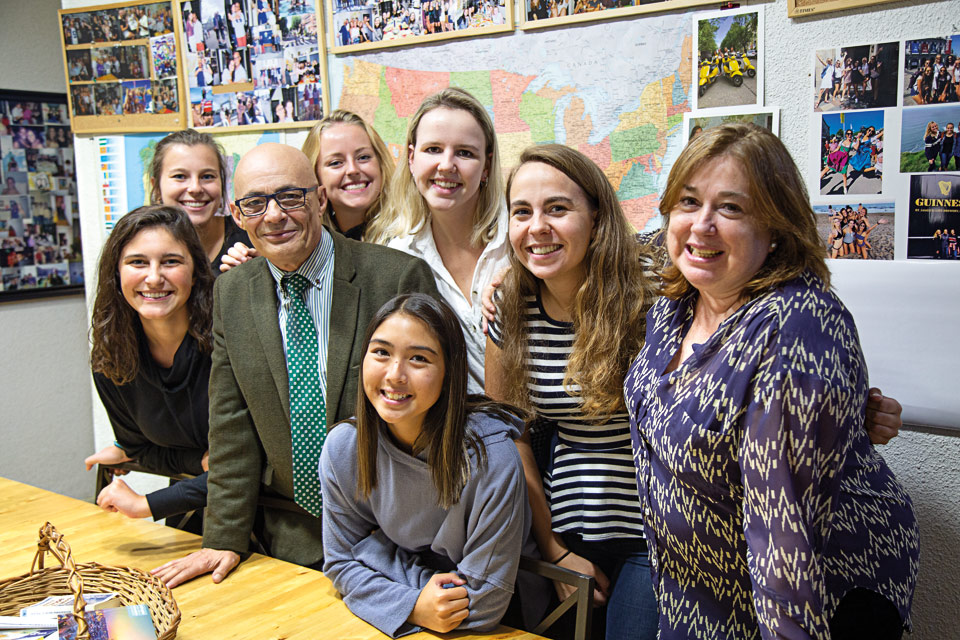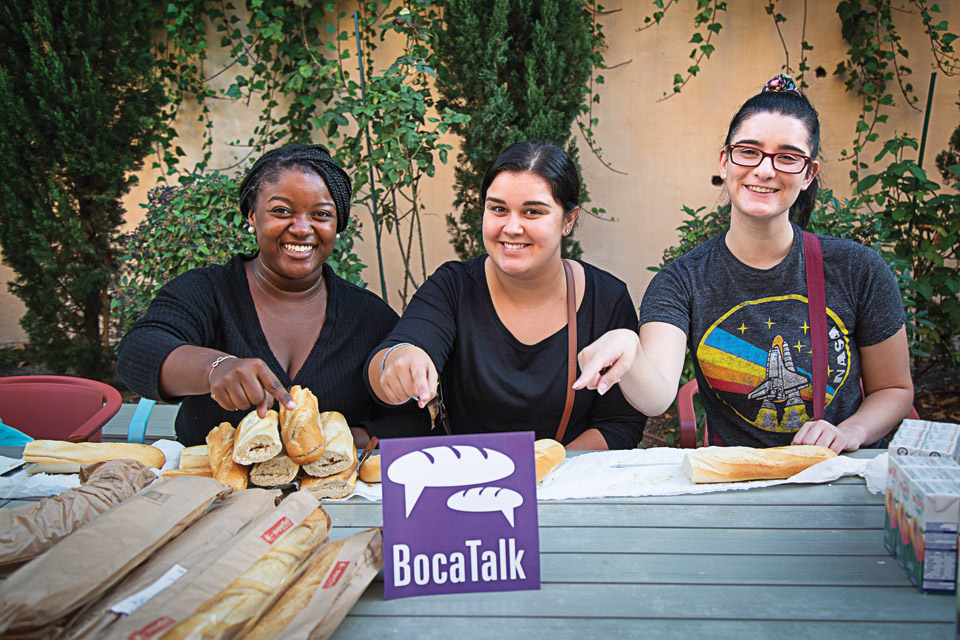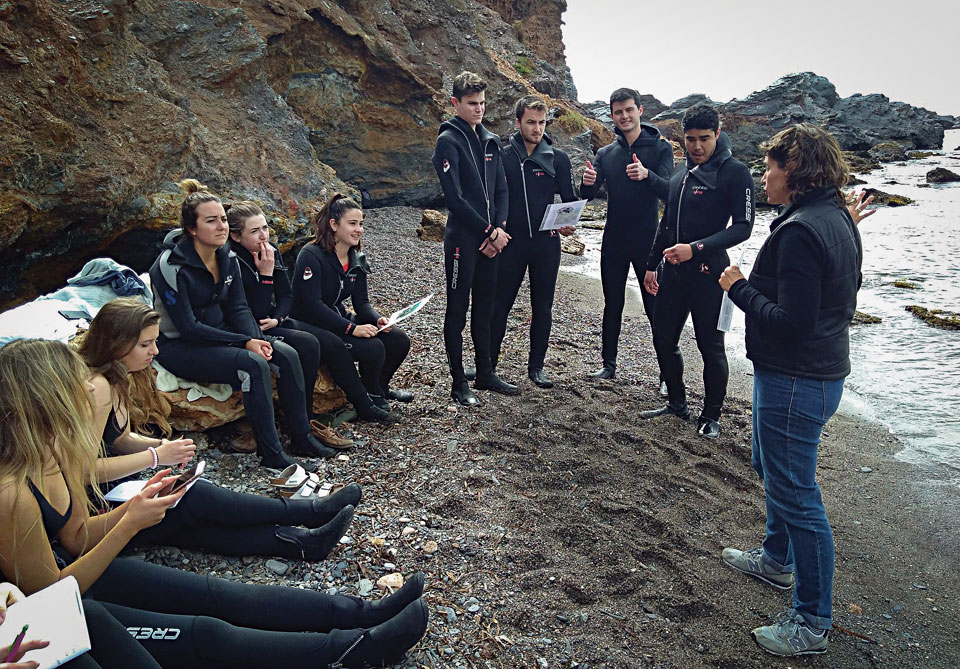¿Sabías? Did you know?
Ten things you might not know about SLU-Madrid
It was founded more than 50 years ago, and records show that at least 6,330 alumni have studied there, but even the most true-blue Billikens probably don’t know all there is to know about Saint Louis University – Madrid. So here are 10 facts that offer the inside scoop on what sets SLU-Madrid apart.
Fact 1: Students can pursue any of the 15 undergraduate and two graduate degree programs entirely in Spain.
Plus, the Madrid Campus enables students to complete requirements for more than half of Saint Louis University’s nearly 100 undergraduate degree programs. For those programs, students begin their studies in Madrid and then transfer to St. Louis to complete their degrees.
The campus has come a long way from its 1967 origins as a study abroad program. And the number of degrees available in Madrid has grown exponentially. In 2006, the campus offered just two bachelor’s degrees that could be completed in Madrid.
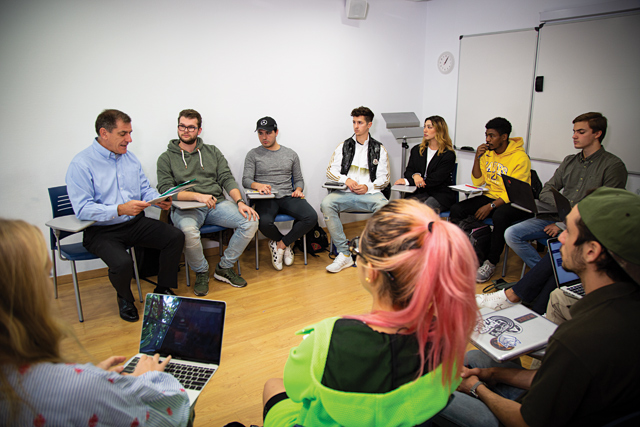
The variety of degree offerings adds to the many reasons SLU-Madrid is a destination for students. “What makes Saint Louis University Madrid Campus attractive to students first is the city of Madrid. You can’t beat it. It’s a vibrant city, it’s an exciting city, it’s a culturally rich city, it’s a city easy to get to from any point in the world,” said Dr. Paul Vita, director and academic dean of Saint Louis University-Madrid.
“The second reason is our American identity,” he continued. “We’re offering something that’s not readily available from the professional degrees offered here at both public and private universities in Spain. We’re also offering American, liberal arts programs outside of the United States, extending the reach of SLU’s degree programs. This opens up programs to students who otherwise couldn’t enter the U.S. for whatever reasons — political, economic, personal or family reasons.
“Thirdly, of course, is our Jesuit identity,” Vita said. “I think many Spaniards and people from around the world recognize that we’re part of a 450-year-old tradition that forms persons for others.”
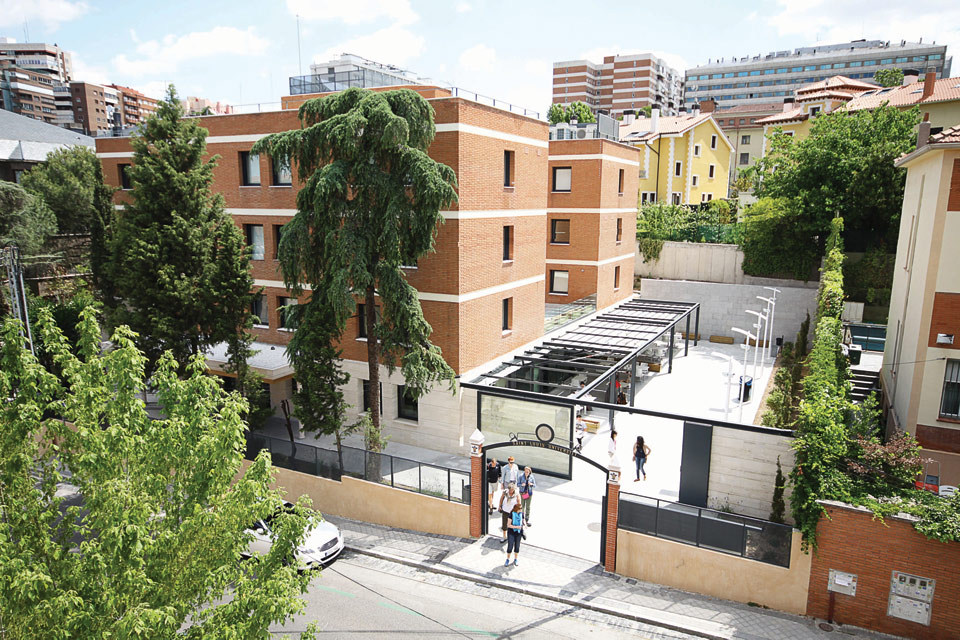
Fact 2: In 1996, SLU-Madrid was the first U.S. university to receive official recognition from the Consejería de Educación y Cultura, Madrid’s higher education ministry.
This formal recognition of SLU-Madrid as an institution of post-secondary education grants it permission to deliver U.S. degree programs in Madrid.
The recognition also ensures that students are receiving an accredited education. “The ministry monitors the educational sector to ensure that all private universities have the appropriate level of faculty qualifications, such as doctorates, and that the institution has the facilities to offer a university education,” Vita explained. “SLU-Madrid does — and goes well beyond.
“Students may not recognize it, but the recognition is a quality assurance that certainly doesn’t apply to most study-abroad programs in Spain or around the world.”
And that’s not the only point of pride for SLU-Madrid. It is the only U.S. university in Europe with a campus that offers 15 distinct undergraduate degree programs. And it’s the only branch campus of a U.S. university to be a member of the Association of American International Colleges and Universities. The campus also received the Heiskell Award from the Institute of International Education for internationalizing professional education with its nursing program.
Fact 3: Students from more than 50 countries pursue degrees and study abroad at SLU's Madrid campus.
Each semester, the campus enrolls approximately 900 students — roughly 500 of whom are studying abroad for the semester and roughly 400 of whom are “permanent” students who will complete their degrees in Spain.
“What makes Saint Louis University Madrid Campus an extraordinary place is its student diversity — all kinds of diversity,” Vita said. “With over 50 nationalities represented in our student body, that means in a single classroom, for example, you’ll have six or seven students from different countries — from China, from Germany, from Morocco and the Philippines, and of course from Spain and the United States.
“Beyond that, we have students from nearly every state,” Vita continued. “And our visiting students are not just from Saint Louis University, by the way, but from other colleges and universities as well.”
Dr. Anne McCabe, who teaches courses in English and communication and was the 2018 recipient of SLU’s Nancy McNeir Ring Award for Excellence in Teaching, said she finds it fascinating to teach students from all around the world. “That’s always been one of my favorite aspects of teaching here at the Madrid Campus because I learn so much from those students,” she said. “I can travel with them to countries that I’ve never visited because through their writing and class discussion I get to know about their culture, about where they’re from, about ways they think.
“And so for me, it’s really opened my eyes to the notion that there’s not just one way of doing things,” she said. “And not even two — not just the American way and the Spanish way. There are multiple ways of doing things—many different ways, for example, of writing. To encounter that in classroom after classroom has been a great learning experience for me.”
Fact 4: Most visiting students live with host families.
The host families, also known as señoras, introduce students to Spanish culture and language firsthand while immersing them in a home environment. The students typically receive two meals per day, laundry service and Wi-Fi.
Many families host two or three students and are located within a quick walk or subway commute from SLU-Madrid.
Aubra Ladd, a SLU junior who studied in Madrid last fall, said she was pleasantly surprised by how handson her host family was. “I thought we were just going to live with them — cohabitation in a sense,” Ladd said. “But it’s like living with your own regular family; you do things together, you go places together, you eat together, you have late-night talks. It’s great.”
Ladd also appreciated the chance to deepen her Spanish fluency. “My host mom only speaks Spanish so it’s a perfect way to practice and be immersed in the culture,” Ladd said. “She sits down and gets to know me and my roommate. And it’s a beautiful experience. You really get to make a bond with someone who is not a student on campus.”
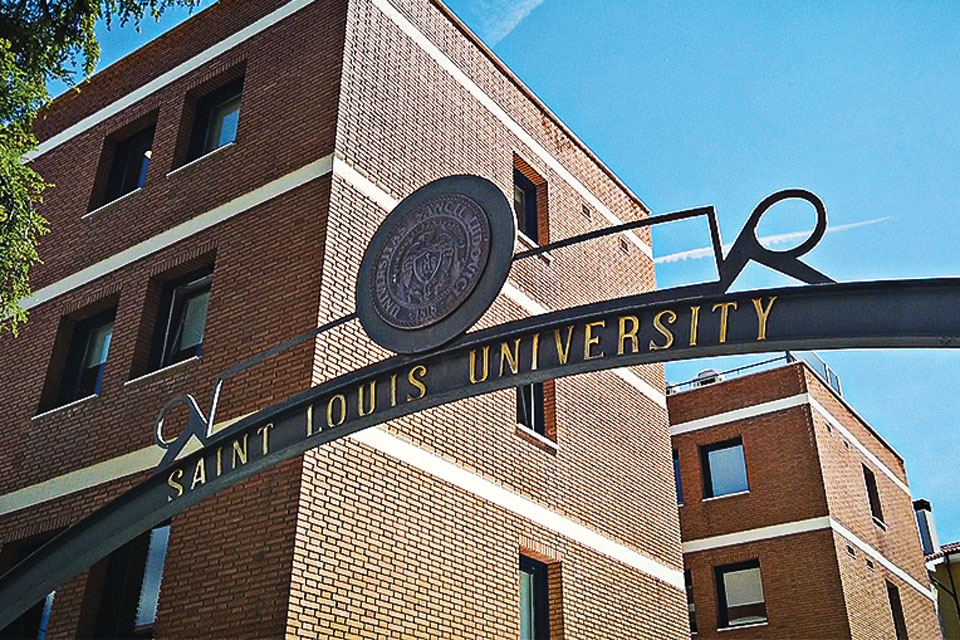
Fact 5: SLU’s campus in Spain features many physical reminders of the “home” campus in St. Louis.
Vita said that is by design. “The Madrid Campus shares Saint Louis University’s mission,” he said. “We’re advancing the same mission here overseas in Spain. There are physical signs of that all over campus — whether it’s the same archway leading into San Ignacio Hall or the statue of St. Ignatius himself. We’re one university, and that’s an important part of the Madrid Campus’ identity.”
Students agree. Matthew Staley, a SLU junior who spent the fall semester at SLU-Madrid, found the campus itself reassuring. “I was a little bit worried about studying abroad and not being able to figure out the university and the campus,” he said. “But when I first came to Madrid, I felt at home right away, just seeing the Billiken and SLU signs all over the walls really made me feel like I was at SLU. Seeing the students wearing their SLU gear — it was incredible to be in another country but also feel at home at the same time.”
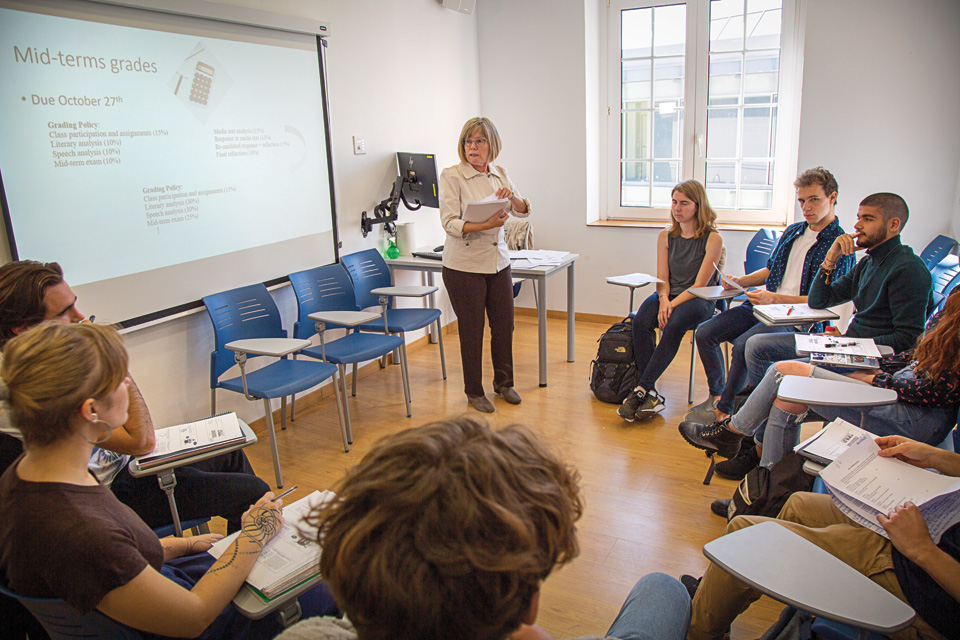
Fact 6: Though selected courses are taught in Spanish, the primary language of instruction is English.
“That’s our distinctive feature,” Vita said. “We’re an American university overseas. That does incredible things. It opens up study abroad to new groups of students who otherwise could never spend a semester in Europe.”
It also reflects the campus’ place within its local community. “Our American, English-speaking identity distinguishes us from the Spanish universities here in Madrid,” Vita said. “We’re offering liberal arts, quality classes, small classes, engaged classes, continuous assessment — in other words, we’re offering a kind of education that’s not readily accessible outside of the United States.”
McCabe, who studied at SLU-Madrid in 1977-78, remembered that at that time, all classes were taught in Spanish, and students were penalized for speaking English. But she’s pleased by the evolution to an English-speaking campus.
“It is beneficial for students coming from a range of contexts,” she said. “Obviously for all of our international students who come in with a first language other than English, it’s fantastic because they really, really get a bilingual level of English. For our American students, the benefit for them is the deep friendships that they can make with people from all over the world through that shared language of English.”
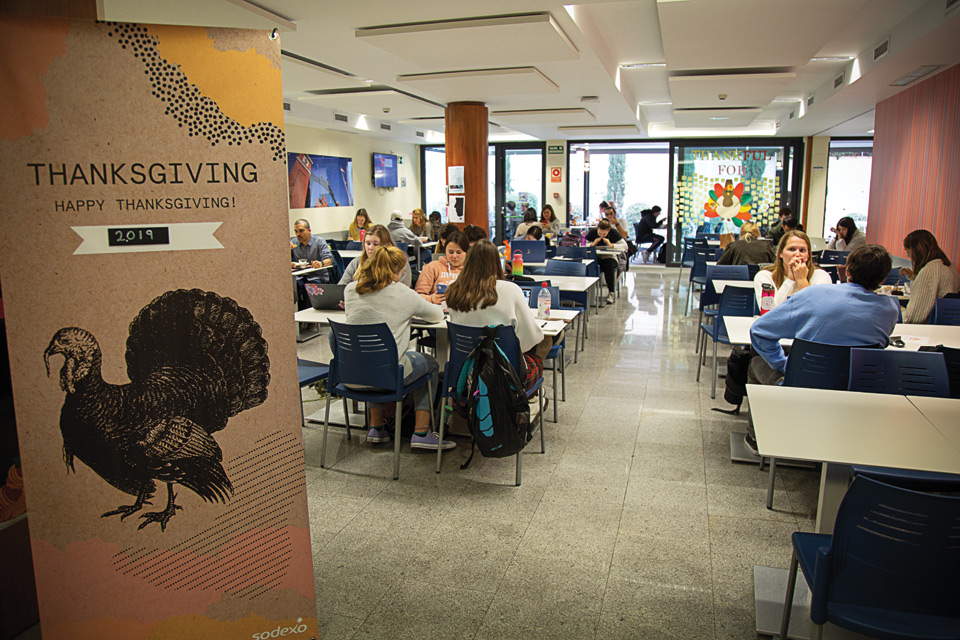
Fact 7: SLU-Madrid stays open to celebrate American holidays such as Thanksgiving and Independence Day.
Vita said the July 4 celebration includes a barbecue and make-your-own ice cream sundae bar. “It’s an opportunity for our community to reflect on our identity as an American community,” he said. “And it also takes a form of sharing American culture with others.”
In addition to an annual food drive for the less fortunate, SLU-Madrid’s Thanksgiving festivities include more than 200 servings of turkey, countless pumpkin pies and some city-wide attention. “One thing that’s fun for our students is that often the local Madrid television station comes to our campus because we’re one of the largest groups of Americans who are celebrating Thanksgiving together,” Vita said. “Thanksgiving also helps us affirm our American identity, as well as reflect on what we’re thankful for.”
Fact 8: Service is a big part of the SLU-Madrid experience.
Each semester, hundreds of SLU-Madrid students volunteer in the local community.
“We think it’s important that our students, especially our visiting students, get out of the little bubble that they might create coming over here with their friends who perhaps all live together and all go out together and all see the same things,” said James O’Leary, S.J., who leads SLU-Madrid’s campus ministry and teaches theology. “Volunteering and serving others allow a student to open his or her eyes to other realities of what Spanish culture and society is all about — of what Spanish people are all about. And I think that understanding broadens our minds to open our hearts to a wider world.”
One popular service opportunity is BocaTalk, a student-run club whose 80 members focus on outreach to Madrid’s homeless population. Students prepare food or other necessities in advance and then go out into the city to distribute the items and have conversations with those living on the streets. “Students try to give Madrid’s homeless people back their dignity as human beings with the excuse of giving them a sandwich or some hygiene products,” said Marta Maruri, SLU-Madrid’s director of student life.
Another longtime service project is SLU-Madrid’s Community ESL (English as a Second
Language) program. Founded in 2002, the program typically engages more than 45 students
each semester to teach English to approximately 300 members of the local community.
The weekly classes, which are offered for free, give students experience as educators
and leaders.
The classes also encourage students to build connections with Madrileños from all
walks of life. Program director for ESL and Modern Languages Hamish Binns assists
with class preparation as needed. “Student-teachers learn as much about the language
and themselves as their adult students,” Binns said.
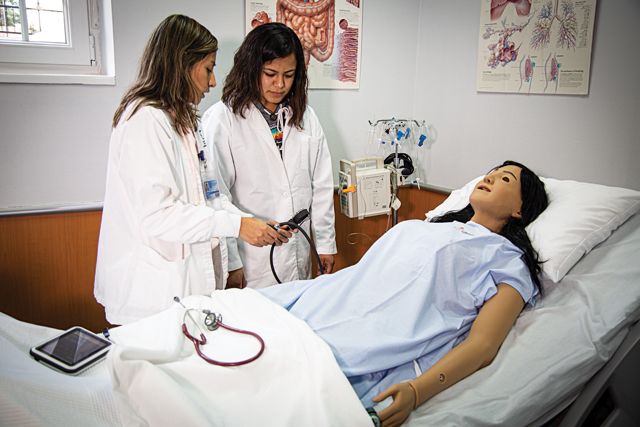
Fact 9: Students studying nursing and engineering can study abroad for a semester — a rarity for those majors.
In nursing, a summer immersion program, launched in 2017, allows students to spend several weeks training in a Spanish hospital with hands-on experiences, such as preparing IV medications. “Our nursing students here at the Madrid Campus have an extraordinary experience,” Vita said. “We have nursing labs, nursing facilities and even more exciting is that many nursing students have their first real clinical experience here in Madrid, Spain.”
In engineering, by offering courses that cover topics such as thermodynamics, material science and organic chemistry, SLU-Madrid opens up unique international experiences to future engineers. In Madrid, students earn the same credits toward SLU’s Parks College of Engineering, Aviation and Technology’s degrees as students in St. Louis.
Vita also is enthused about the opportunities for engineering students to study abroad. “Engineering itself is an international profession, and it’s important for future engineers to develop that sensibility of working with people from around the world from the start,” he said. “Thus, we’re designing programs that connect our U.S. engineers who are visiting our campus for a term with our permanent students who are starting their degrees here and planning to continue in St. Louis. This creates a dynamic international experience in the classroom, which we increase further by offering special trips within Madrid and to Toulouse, France, to see the Airbus factory.”
Fact 10: Classes and field trips at SLU-Madrid take full advantage of the campus’ setting.
Students can learn flamenco dancing. They can take a trip to Loyola, Spain, for the Loyola Pilgrimage Retreat, which traces the life of St. Ignatius, founder of the Jesuits. Other opportunities send students across Europe to locations such as Stratford-upon-Avon in England.
“Faculty have developed unique courses and special programs that are inventive and exciting,” Vita said. “Our art history courses take you into the Prado, into the Reina Sofia, up to Bilbao to see the Guggenheim.”
“In oceanography class we have a field trip to one of the areas in Spain that I think if you didn’t participate in the class you would never go to,” said Mónica Pérez-Bedmar, a professor in the Department of Natural Sciences. “We get to see fish markets, we get to see coastal ecosystems that are in serious stress now. Basically, students see what the main problems of the Mediterranean Sea are. And they get to talk about the solutions to the coastal ecosystems.”
“These learning experiences only make sense,” Vita said. “We’ve gone out of our way to develop courses and programs that take advantage of the rich city of Madrid but also of the wonderful international identity of our own student body, courses that help students discover who they are by getting to know students from other places with other values. We have 15 degrees here in Madrid and not every degree because we’ve purposely focused on those degrees that make sense to offer in this international setting — programs such as international business, international relations and Spanish, of course, too.”
— By Laura Geiser, photos by Fernando Béjar
Saint Louis University is a Catholic, Jesuit institution that values academic excellence, life-changing research, compassionate health care, and a strong commitment to faith and service. Founded in 1818, the University fosters the intellectual and character development of more than 13,000 students on campuses in St. Louis and Madrid, Spain. Building on a legacy of now more than 200 years, Saint Louis University continues to move forward with an unwavering commitment to a higher purpose, a greater good.


















